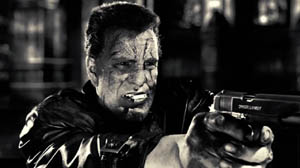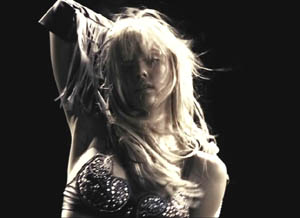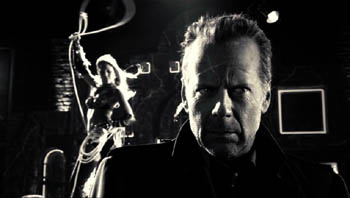|
See? It's not true that no one will go to see a black-and-white film anymore. If you put lots of boobs and gunfire in it, people will watch pretty much anything. 
At present, Sin City is in all likelihood the most faithful book-to-film adaptation ever made, with the possible exception of Fear and Loathing in Las Vegas. Or, at least, most faithful adaptation of a graphic novel-read as "comic book for people who don't like to say 'comic book.'" Ostensible director Robert Rodriguez stated that he wanted to make Frank Miller's Sin City, not his own version, and fought the Director's Guild for Miller's inclusion in the credits as co-director. The Guild refused, so Rodriguez quit and did it his way anyway. Whatever one thinks of the man's films, there's much to be admired about Robert Rodriguez, a self-made success who's not only done things his own way from the beginning, but who's constantly pushed the rules and the technologies to make the process of making one's own movies easier for new filmmakers. The thing is, however, that by his own choice, there's very little of Rodriguez in this film; he didn't write it, and the directing credit really did belong more to the comic's creator, Frank Miller, than it did to him. The shot composition is straight off the page, along with every utterance. In many ways, this might not have been the best idea. The world of Sin City is one of overamped noir, a dark, grim place where guys talk tough and brutalize one another whilst mentally waxing poetic, and women in general have no problem with walking around naked and never go so old-fashioned as to wear undies that don't crawl up their butts. The world is wholly corrupt, innocent people get snuffed as matters of circumstance, and heroes are mostly distinguished from villains by some sort of personal code, not from the size of the body count they leave behind them. In the course of the film, three loosely entwined stories tell of three male protagonists-the term "heroes" isn't really appropriate-who set out to protect or avenge a woman or group of women. Much death, crime and torture occur along the way, in what is one of the most gleeful displays of nihilism in film (or techinically hi-def video) that I've ever seen. 
It's impossible not to notice the visual style; it vertiably demands attention and comment. Shot pretty much entirely on green-screen with ultra-sharp video, the image is a harsh black-and-white with splashes of color here and there, in a dress or a girl's eyes, or, often enough, in blood. The compositing of the actors into the artificial backgrounds is extraordinarily clean, but creates a final image which is hyper-stylized and never quite real; whether or not this bugs or enthralls you is a matter of personal aesthetics, though for myself, it seems like one of those decisions, like the extremely purple dialogue, that worked better in the comic than it does here. Maybe it's me; I just always think of that Mountain Dew ad from back in the '80s, where the drink was pink (I don't think they make this anymore) and everything else was black-and-white. Not the filmmaker's fault, that, but it seems to mostly serve the same purpose here as there, which is that of a simple visual gimmick that draws your attention but ultimately conveys nothing. 
The acting overall is excellent, and given the general lack of a visual context for the actors, this might be the one contribution creditable to Robert Rodriguez. In most other respects, however, he seems to have abdicated his job by basically refusing to change a hair of the comics, even down to the excess of expository dialogue. A book has a more dialated sense of time; a movie that keeps explaining what's going on, even during an action scene, is slowing itself down by telling you things it should just be showing you. Still, part of what I find problematic about Sin City is inextricably linked to its source material. For its noir-loving stylings, these stories are hardly in the same league with Chandler or Hammett; they're mostly pretty simple plots with few twists of a surprising nature and a lot of really graphic killings and mutilations. The best of the tales features Bruce Willis as an aging cop with an actual sense of decency who's out to save a young stripper, played by a perpetually-clothed Jessica Alba (who needs to get past the notion that having a lump of shrapnel lodged in her navel is in any way attractive). The story works best for me because it mananges some actual emotion amidst the carnage, though it seems rickety in its plot from time to time (when did Nancy Callahan's identity somehow become unknown to her former kidnappers, anyway?). Beyond that, the stories are involving but not particularly gripping, and I find myself wishing for a little more of the director's voice. Rodriguez may not be the best writer out there, but the films he pens himself tend to be a lot less self-serious and a lot more fun. -review by Matt Murray
|
|
||||||||